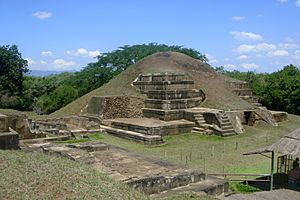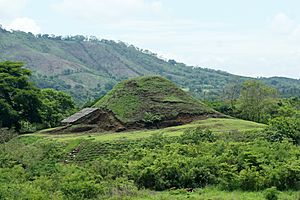San Andrés, El Salvador facts for kids
San Andrés (also known as Campana San Andrés) is an ancient city in El Salvador. It was first settled around 900 BC as a farming village in the Zapotitán valley. People lived there until about 250 AD, when a huge volcano called Lago Ilopango erupted. The area was empty for a while but people moved back in the 5th century. Between 600 and 900 AD, San Andrés became the main city of a Maya kingdom, controlling other towns in the Zapotitán Valley.
Contents
Exploring Ancient San Andrés
Archaeologists have studied the main part of San Andrés, where the rulers lived and important ceremonies took place. This area was split into two sections: the South Seat and the North Seat.
The Acropolis: Heart of the City
Around 600 AD, the South Seat was filled in with adobe (a type of mud brick) to build a large platform called the Acropolis. This platform held important buildings for government and religious events.
- Main Pyramids: On the south and east sides of the Acropolis, you can find pyramids and structures numbered 1, 2, 3, and 4. Structure 1 is the main pyramid.
- Rulers' Homes: On the north and west sides, there were rooms where the leaders of San Andrés lived. Two of these palaces have been rebuilt.
- Ceremonial Structure 7: To the south of the Acropolis is Structure 7, another important building for ceremonies.
La Campana: The North Seat
The North Seat, also called the Great Seat, has a pyramid known as Structure 5, or "La Campana" (The Bell). This pyramid is connected to the Acropolis by Structure 6, which is shaped like an "L". Around Structure 5, there were buildings where people traded goods.
San Andrés and Its Neighbors
Archaeological finds show that San Andrés had strong connections with other important cities like Copán and places in the Guatemalan Highlands. They even received goods from far-off areas like modern-day Petén and Belize. San Andrés stopped being a major political center around the end of the 9th century.
Later Life in San Andrés
After the Maya kingdom ended, people still lived in San Andrés between 900 and 1200 AD. Archaeologists found pieces of incense burners and pottery painted with scenes of sacrifice. These items belong to a new cultural period called Guazapa, which is linked to the ancient city of Cihuatán.
San Andrés After the Spanish
After the Spanish arrived, the ruins of San Andrés became part of a large farm. This farm raised cattle and grew plants to make indigo, a blue dye. In 1658 AD, another volcano, Playón, erupted and buried the site. This eruption actually helped preserve the old indigo production area almost perfectly!
In 1996, the government of El Salvador opened the Archaeological Park of San Andrés. Today, visitors can climb the pyramids, see the indigo production area, and visit the museum at the site.
See also
 In Spanish: San Andrés (sitio arqueológico) para niños
In Spanish: San Andrés (sitio arqueológico) para niños



